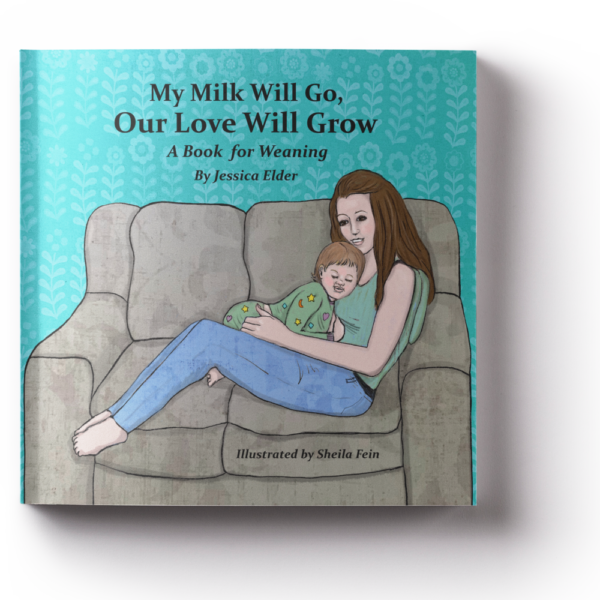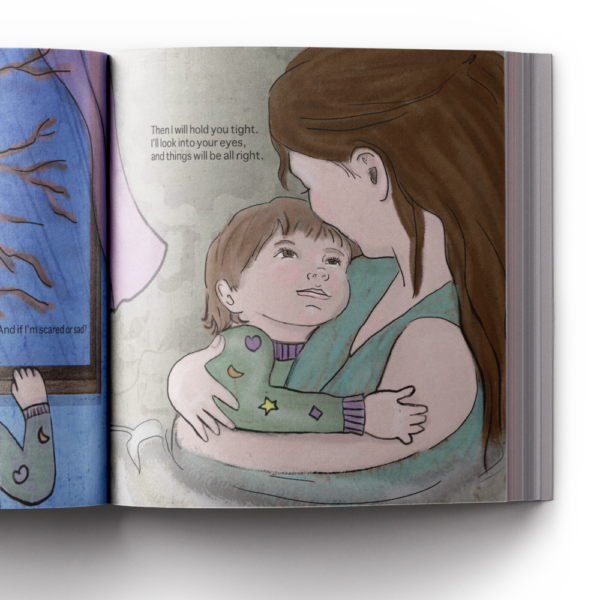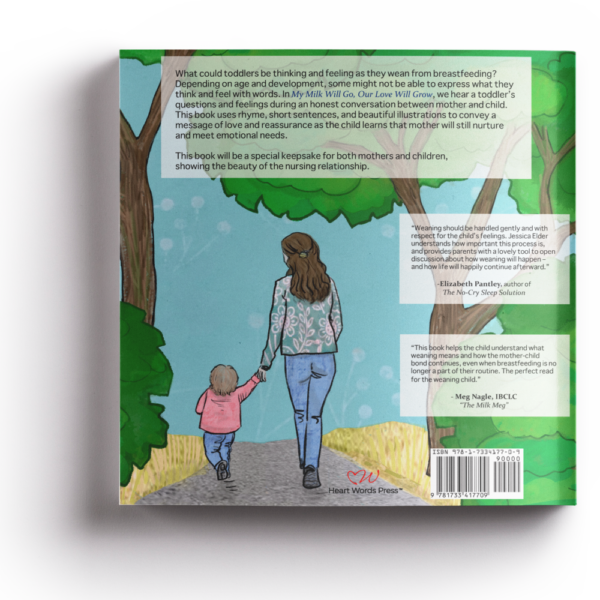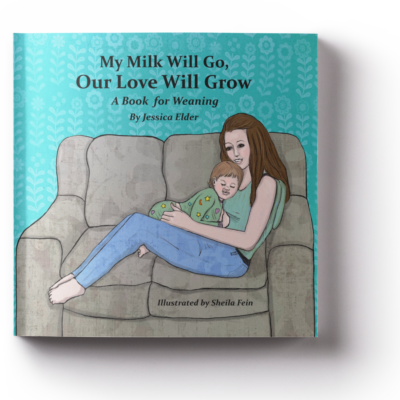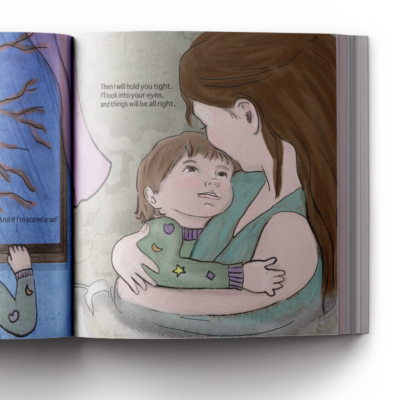My Milk Will Go, Our Love Will Grow
by Jessica Elder, LCSW-AZ-NY
Illustrated by Sheila Fein
Publisher: Heart Words Press
Book Description
Before becoming a nursing mother I did not truly understand everything a baby gained through the nursing relationship. I did not know that nursing could comfort every fear, pain, worry, and emotion. I later learned that nursing was more than milk and comfort… it was also communication. When I became a nursing mother, I realized that babies not only want to nurse when they are thirsty and hungry, but also when they are thinking: I love you, I miss you, I want to be with you, I need you, I’m scared, I’m anxious, I’m tired, or I want to feel safe. To a baby, nursing can be a mother’s way of responding and saying, “I hear you. I’m here for you. I love you.” Of course nursing is not the only way a mother can meet these needs, but I am referring to my own personal experience.
When I was preparing to stop nursing, I wished for a book to help me communicate with my toddler. While I did purchase a couple of nice weaning books, I still wished for a book that focused on validating the thoughts and emotions a toddler might feel during the weaning process. I was still able to gently wean my first child, but I later realized that I did not say everything I wanted to say to him about the process.
One day, while nursing and holding my second baby, I thought about everything I wish I would have said to my first born son during the weaning process. The words suddenly came to me and I wrote the first version of my book in the notes app of my phone, while holding a sleeping baby. I wrote the book with a strong focus on the love and bond between mother and child. Although I had never thought about publishing a book before, I decided to publish it to share with mothers and children.
Read Reviews by My Readers
The Story Behind My Milk Will Go, Our Love Will Grow
Before becoming a nursing mother I did not truly understand everything a baby gained through the nursing relationship. I did not know that nursing could comfort every fear, pain, worry, and emotion. I later learned that nursing was more than milk and comfort… it was also communication. When I became a nursing mother, I realized that babies not only want to nurse when they are thirsty and hungry, but also when they are thinking: I love you, I miss you, I want to be with you, I need you, I’m scared, I’m anxious, I’m tired, or I want to feel safe. To a baby, nursing can be a mother’s way of responding and saying, “I hear you. I’m here for you. I love you.” Of course nursing is not the only way a mother can meet these needs, but I am referring to my own personal experience.
When I was preparing to stop nursing, I wished for a book to help me communicate with my toddler. While I did purchase a couple of nice weaning books, I still wished for a book that focused on validating the thoughts and emotions a toddler might feel during the weaning process. I was still able to gently wean my first child, but I later realized that I did not say everything I wanted to say to him about the process.
One day, while nursing and holding my second baby, I thought about everything I wish I would have said to my first born son during the weaning process. The words suddenly came to me and I wrote the first version of my book in the notes app of my phone, while holding a sleeping baby. I wrote the book with a strong focus on the love and bond between mother and child. Although I had never thought about publishing a book before, I decided to publish it to share with mothers and children.

Breastfeeding and Weaning Resources
My book was written to help parents communicate with their toddlers about weaning. The conversation within the book can guide parents as they prepare toddlers for this transition in a sensitive manner, and provide them with answers to questions they may have around the transition. Here I have provided some of my favorite gentle weaning information and techniques to further assist you throughout nursing and weaning. In addition to listing some of the tips, I added comments about my personal experience following the tips.
The following information and tips are summarized from the La Leche League website. For the complete list of tips and for more information please visit the LLL website.
Breastfeed when your toddler asks, and do not offer when he doesn’t (the “don’t offer don’t refuse” technique). This is a strategy I used during my daytime weaning process since my situation allowed me to wean gradually. It helped me to ease into weaning and cut down on nursing in a way that felt natural and comfortable.
Change daily routines. Avoid spots or chairs you typically use for nursing as much as possible. Stand up as much as possible. This tip was also very helpful to me throughout my gradual weaning process. I found that any time I was sitting down whether it be on a couch, chair or floor, my young toddler wanted to nurse. It was very helpful to get out of the house for outings and activities that excited my toddler. Simply playing outside instead of inside helped a lot.
If possible, get help from other family and household members. Have your partner assist during times when your toddler wants to nurse. I found it helpful to have my husband take our toddler out or initiate more play time when possible.
Offer substitutions and distractions. Try offering a snack or drink, or take him out somewhere fun during a nursing time. Distractions can be activities and outings. Playing outside, going out for activities, visiting new places, taking walks, etc.
Shorten length of nursing. My toddlers all accepted this unless it was during a time when they needed extra comfort. When they needed the extra comfort I did not attempt to shorten the length of nursing.
The following information and tips are summarized from the Kelly Mom breastfeeding site and was written by Kelly Bonyata, IBCLC, Becky Flora, IBCLC and Paula Yount. For the complete list of tips and for more information please visit the Kelly Mom website.
The Kelly Mom site mentioned many of the same tips from the LLL site. In addition to talking about “don’t offer don’t refuse,” they discuss the idea of dropping one feeding at a time. For example, drop one feeding for 3-7 days before dropping the next. They suggest choosing a feeding that is least important and offering a snack/distraction instead of nursing (or begin with shortening the session). Once you have eliminated the one feeding and are comfortable (with no fullness), you can move on to the next. They feel you should not refuse if baby really wants to nurse during the session you just dropped. They recommend taking your time with naptime, bedtime, and morning wake up feedings as these are usually the last to end.
Postponement is another technique. When your child asks to nurse, say “Not now, later.” Sometimes he will get busy and forget to ask again. He also learns that he can wait.
The Kelly Mom site advises to not try day and night time weaning all at once.
If the toddler is sleeping with you, you might consider moving him to his own bed or into a bed with an older sibling. However, if he resists the move, he may want to nurse more to maintain closeness with you. We chose to keep our toddlers in our bed during weaning because this is what worked best for us. I felt they would have had a difficult time adjusting to both a new bed and to weaning all at once. But, this is something to consider as I know it has helped mothers with night weaning.
Allow other family members to help by taking over sleep-time routines. Depending on your situation it may or may not be possible to try this.
Offer drink of water or snack if child seems hungry or thirsty.
Offer cuddles, hugs and music to replace nursing at night or nap time. For each child, we were able to maintain a beautiful bedtime routine with connection and bonding.
La Leche League states that if weaning is going to quickly for your child, he’ll usually let you know by his behavior. Increased tantrums, regressive behaviors, anxiety, increase in night waking, new fear of separation, and clinginess are all possible signs. Illness and teething can also interfere with weaning and sometimes you have to take a break. With my first son, night weaning went pretty smoothly, although it was not easy. He was able to accept that there would be no night nursing after 2 challenging nights of attempting night time weaning techniques. However, the first attempt I made at night weaning my second son failed. He was too angry and upset and I immediately knew that I had to stop and try again in another month. Taking a break was exactly what we needed.
If night weaning is not going well, consider taking a break from it. Try introducing it again a little later. If your child is closer to reaching this milestone on his own, weaning will be easier for both the child and parents. “Getting your baby to sleep is not a battle to be won, as it is so often portrayed in books and the media. The real goal should be for your family to get the sleep they need, while respecting the needs of the youngest family member(s).”
Limit access: wear clothing that makes it harder for baby to access your breast at night.
Increase daytime contact. Sometimes toddlers want to nurse more at night if they aren’t getting enough close contact and cuddling during the day. Moms get busy and sometimes forget to just sit and cuddle with their toddlers.
Substitute with other comfort: A back rub, holding and cuddling, getting him a drink of water, humming softly, etc.
Sign up here to receive a free gentle weaning guide that includes tips to emotionally support both you and your child through this transition!

